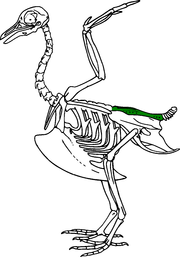
Synsacrum
Encyclopedia

Dinosaur
Dinosaurs are a diverse group of animals of the clade and superorder Dinosauria. They were the dominant terrestrial vertebrates for over 160 million years, from the late Triassic period until the end of the Cretaceous , when the Cretaceous–Paleogene extinction event led to the extinction of...
s, in which the sacrum
Sacrum
In vertebrate anatomy the sacrum is a large, triangular bone at the base of the spine and at the upper and back part of the pelvic cavity, where it is inserted like a wedge between the two hip bones. Its upper part connects with the last lumbar vertebra, and bottom part with the coccyx...
is extended by incorporation of additional fused or partially-fused caudal or lumbar vertebrae. The ilium
Ilium (bone)
The ilium is the uppermost and largest bone of the pelvis, and appears in most vertebrates including mammals and birds, but not bony fish. All reptiles have an ilium except snakes, although some snake species have a tiny bone which is considered to be an ilium.The name comes from the Latin ,...
of the pelvis
Pelvis
In human anatomy, the pelvis is the lower part of the trunk, between the abdomen and the lower limbs .The pelvis includes several structures:...
is attached to the synsacrum and, in some species, may also be fused to it. Together with the pelvis this forms a rigid structure which carries the weight of the hind end of the animal. In living and some prehistoric birds, posterior to the synsacrum there are usually only a few free caudal vertebrae, on the end of which lies the pygostyle
Pygostyle
Pygostyle refers to a number of the final few caudal vertebrae fused into a single ossification, supporting the tail feathers and musculature. In modern birds, the rectrices attach to these....
.
In terms of external morphology, the synsacrum corresponds to the rump.

